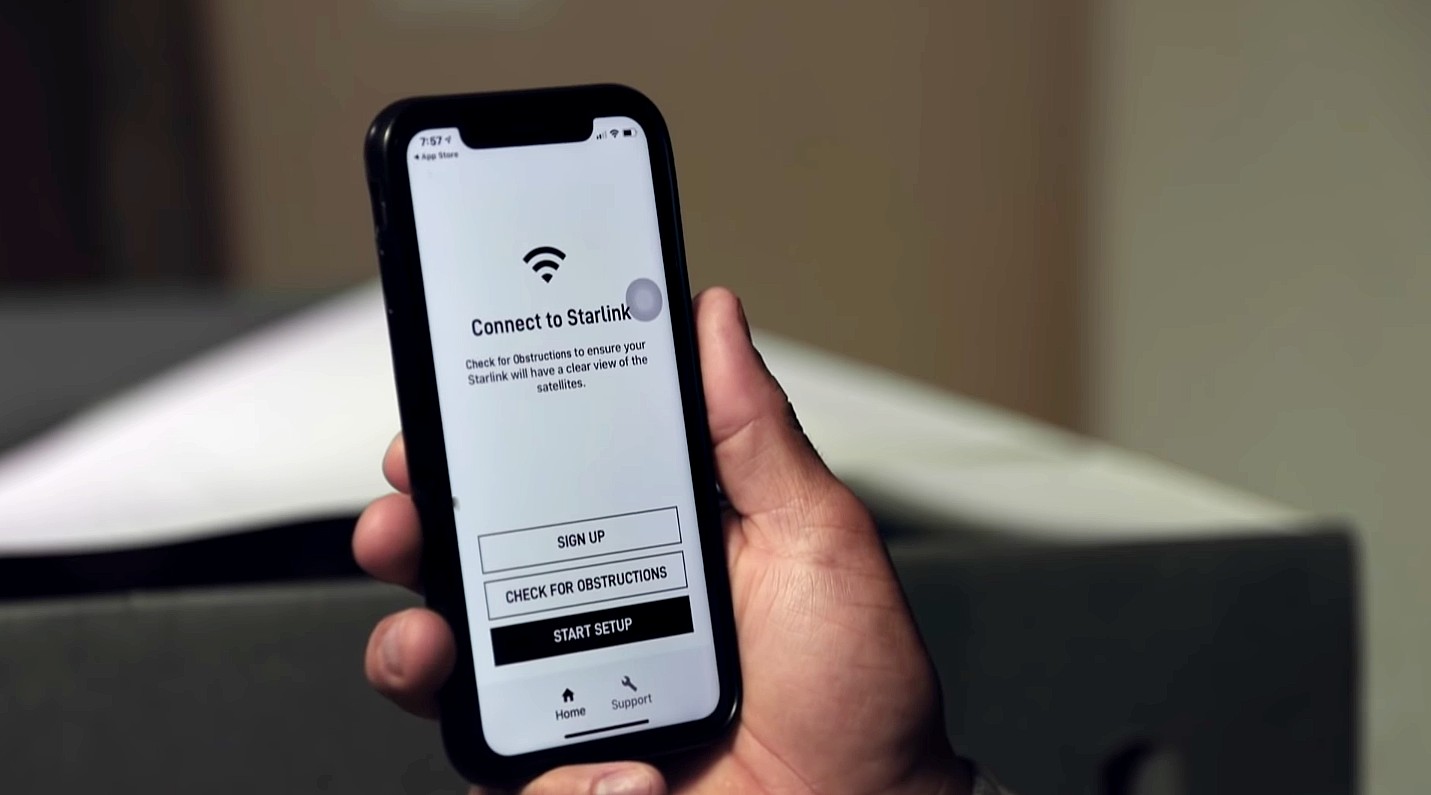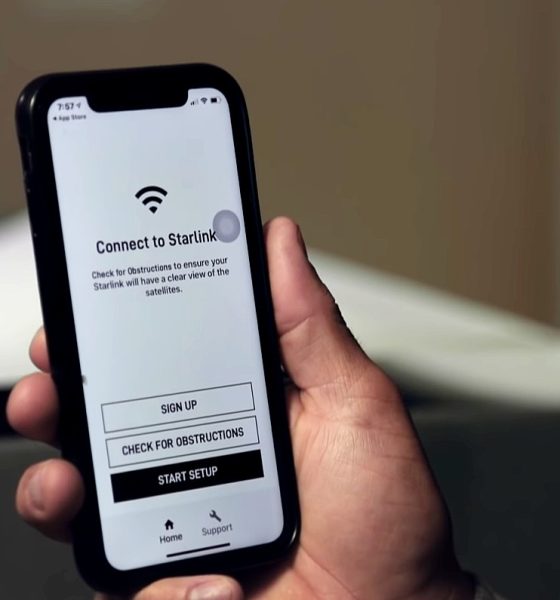

News
Elon Musk’s Starlink filings show plans for phone service and low-income web access
It appears that Elon Musk’s Starlink satellite constellation is not just aiming to provide high-speed internet service. Based on recent filings to the Federal Communications Commission (FCC), Starlink also plans to introduce a suite of related products to its portfolio, from a dedicated phone service, emergency backup for voice calls, and more affordable internet access for low-income customers through the US government’s Lifeline program.
Details of Starlink’s expanded services were mentioned in SpaceX’s petition to the FCC for a designation as an Eligible Telecommunications Carrier (ETC). According to the Elon Musk-led company, an ETC designation is required in some US states where the satellite internet program won government funding to provide internet access to underserved areas. It is also required to receive reimbursement from the FCC’s Lifeline program, which offers discounts on telecom services for low-income customers.
Starlink’s beta today only offers internet access, but in its filing, SpaceX noted that “Starlink Services will provide voice telephony services, including: (a) voice-grade access to the public switched telephone network (‘PSTN’) or its functional equivalent; (b) minutes of use for local service provided at no additional charge to end-users; (c) access to emergency services; and (d) toll limitation services to qualifying low-income consumers in accordance with 47 CFR §§ 54.500, et seq. Starlink Services will offer voice services on a standalone basis at rates that are reasonably comparable to urban rates.”
SpaceX further mentioned that in its baseline plan, “Starlink Services would provide telephone services connecting consumers to its MSP’s platform using its network capacity, which is available to consumers through their customer premises equipment.” Interestingly enough, the Elon Musk-led company added that Starlink customers would have the option to use a third-party, conventional phone for its service. This may prove to be a key selling point for the service, especially considering the mobile market’s robust options today.
Like other VoIP providers, SpaceX’s FCC filings have also mentioned that Starlink will sell a 24-hour battery backup to customers. Such a product would allow customers to access Starlink’s services even in the event of a power outage or other emergency situations. These redundancies would not only be applied at the user level, either, as backups would also be implemented at the network level, as per Ars Technica.
“At the user level, Starlink Services will offer a 24-hour battery backup option for user equipment that will provide the ability to make phone calls in the event of a power outage. At the system level, Starlink Services is building redundancy into the network. For example, every user will have multiple satellites in view with which it can communicate. Additionally, every satellite will have multiple gateway sites in view with which it can communicate. The Starlink traffic routing system ensures that every user is served with bandwidth before users demanding more bandwidth get additional throughput assigned, which gives the Starlink network robustness in the event of emergencies requiring high throughput,” SpaceX noted.
Starlink’s battery backup technology would likely be cost-effective and industry-leading considering that Tesla, an electric car and energy company also led by Elon Musk, is developing its own custom battery cells. If SpaceX ends up leveraging Tesla’s batteries like the company’s custom-designed 4680 tabless cells, Starlink’s 24-hour backup batteries may very well become one of, if not the best in the industry.
Apart from a dedicated phone service and a 24-hour backup battery, SpaceX also discussed a program that would bring Starlink’s services to low-income households. SpaceX’s FCC filings did not include much details about this program for now. However, considering that the Lifeline program currently provides a $9.25 monthly subsidy for low-income households to get broadband access or a $5.25 monthly per household subsidy for phone service, as well as the fact that the Starlink beta currently costs $99 per month, there seems to be a fair chance that SpaceX would offer a lower-cost version of its satellite internet service in the future.
Read SpaceX’s FCC petition for an ETC designation below.
Starlink Services LLC ETC Designation Application.pdf by Simon Alvarez on Scribd
Don’t hesitate to contact us for news tips. Just send a message to tips@teslarati.com to give us a heads up.

Elon Musk
Elon Musk’s X will start using a Tesla-like software update strategy
The initiative seems designed to accelerate updates to the social media platform, while maintaining maximum transparency.

Elon Musk’s social media platform X will adopt a Tesla-esque approach to software updates for its algorithm.
The initiative seems designed to accelerate updates to the social media platform, while maintaining maximum transparency.
X’s updates to its updates
As per Musk in a post on X, the social media company will be making a new algorithm to determine what organic and advertising posts are recommended to users. These updates would then be repeated every four weeks.
“We will make the new 𝕏 algorithm, including all code used to determine what organic and advertising posts are recommended to users, open source in 7 days. This will be repeated every 4 weeks, with comprehensive developer notes, to help you understand what changed,” Musk wrote in his post.
The initiative somewhat mirrors Tesla’s over-the-air update model, where vehicle software is regularly refined and pushed to users with detailed release notes. This should allow users to better understand the details of X’s every update and foster a healthy feedback loop for the social media platform.
xAI and X
X, formerly Twitter, has been acquired by Elon Musk’s artificial intelligence startup, xAI last year. Since then, xAI has seen a rapid rise in valuation. Following the company’s the company’s upsized $20 billion Series E funding round, estimates now suggest that xAI is worth tens about $230 to $235 billion. That’s several times larger than Tesla when Elon Musk received his controversial 2018 CEO Performance Award.
As per xAI, the Series E funding round attracted a diverse group of investors, including Valor Equity Partners, Stepstone Group, Fidelity Management & Research Company, Qatar Investment Authority, MGX, and Baron Capital Group, among others. Strategic partners NVIDIA and Cisco Investments also continued support for building the world’s largest GPU clusters.
News
Tesla FSD Supervised wins MotorTrend’s Best Driver Assistance Award
The decision marks a notable reversal for the publication from prior years, with judges citing major real-world improvements that pushed Tesla’s latest FSD software ahead of every competing ADAS system.

Tesla’s Full Self-Driving (Supervised) system has been named the best driver-assistance technology on the market, earning top honors at the 2026 MotorTrend Best Tech Awards.
The decision marks a notable reversal for the publication from prior years, with judges citing major real-world improvements that pushed Tesla’s latest FSD software ahead of every competing ADAS system. And it wasn’t even close.
MotorTrend reverses course
MotorTrend awarded Tesla FSD (Supervised) its 2026 Best Tech Driver Assistance title after extensive testing of the latest v14 software. The publication acknowledged that it had previously criticized earlier versions of FSD for erratic behavior and near-miss incidents, ultimately favoring rivals such as GM’s Super Cruise in earlier evaluations.
According to MotorTrend, the newest iteration of FSD resolved many of those shortcomings. Testers said v14 showed far smoother behavior in complex urban scenarios, including unprotected left turns, traffic circles, emergency vehicles, and dense city streets. While the system still requires constant driver supervision, judges concluded that no other advanced driver-assistance system currently matches its breadth of capability.
Unlike rival systems that rely on combinations of cameras, radar, lidar, and mapped highways, Tesla’s FSD operates using a camera-only approach and is capable of driving on city streets, rural roads, and freeways. MotorTrend stated that pure utility, the ability to handle nearly all road types, ultimately separated FSD from competitors like Ford BlueCruise, GM Super Cruise, and BMW’s Highway Assistant.
High cost and high capability
MotorTrend also addressed FSD’s pricing, which remains significantly higher than rival systems. Tesla currently charges $8,000 for a one-time purchase or $99 per month for a subscription, compared with far lower upfront and subscription costs from other automakers. The publication noted that the premium is justified given FSD’s unmatched scope and continuous software evolution.
Safety remained a central focus of the evaluation. While testers reported collision-free operation over thousands of miles, they noted ongoing concerns around FSD’s configurable driving modes, including options that allow aggressive driving and speeds beyond posted limits. MotorTrend emphasized that, like all Level 2 systems, FSD still depends on a fully attentive human driver at all times.
Despite those caveats, the publication concluded that Tesla’s rapid software progress fundamentally reshaped the competitive landscape. For drivers seeking the most capable hands-on driver-assistance system available today, MotorTrend concluded Tesla FSD (Supervised) now stands alone at the top.
News
Elon Musk’s Grokipedia surges to 5.6M articles, almost 79% of English Wikipedia
The explosive growth marks a major milestone for the AI-powered online encyclopedia, which was launched by Elon Musk’s xAI just months ago.

Elon Musk’s Grokipedia has grown to an impressive 5,615,201 articles as of today, closing in on 79% of the English Wikipedia’s current total of 7,119,376 articles.
The explosive growth marks a major milestone for the AI-powered online encyclopedia, which was launched by Elon Musk’s xAI just months ago. Needless to say, it would only be a matter of time before Grokipedia exceeds English Wikipedia in sheer volume.
Grokipedia’s rapid growth
xAI’s vision for Grokipedia emphasizes neutrality, while Grok’s reasoning capabilities allow for fast drafting and fact-checking. When Elon Musk announced the initiative in late September 2025, he noted that Grokipedia would be an improvement to Wikipedia because it would be designed to avoid bias.
At the time, Musk noted that Grokipedia “is a necessary step towards the xAI goal of understanding the Universe.”
Grokipedia was launched in late October, and while xAI was careful to list it only as Version 0.1 at the time, the online encyclopedia immediately earned praise. Wikipedia co-founder Larry Sanger highlighted the project’s innovative approach, noting how it leverages AI to fill knowledge gaps and enable rapid updates. Netizens also observed how Grokipedia tends to present articles in a more objective manner compared to Wikipedia, which is edited by humans.
Elon Musk’s ambitious plans
With 5,615,201 total articles, Grokipedia has now grown to almost 79% of English Wikipedia’s article base. This is incredibly quick, though Grokipedia remains text-only for now. xAI, for its part, has now updated the online encyclopedia’s iteration to v0.2.
Elon Musk has shared bold ideas for Grokipedia, including sending a record of the entire knowledge base to space as part of xAI’s mission to preserve and expand human understanding. At some point, Musk stated that Grokipedia will be renamed to Encyclopedia Galactica, and it will be sent to the cosmos.
“When Grokipedia is good enough (long way to go), we will change the name to Encyclopedia Galactica. It will be an open source distillation of all knowledge, including audio, images and video. Join xAI to help build the sci-fi version of the Library of Alexandria!” Musk wrote, adding in a later post that “Copies will be etched in stone and sent to the Moon, Mars and beyond. This time, it will not be lost.”








